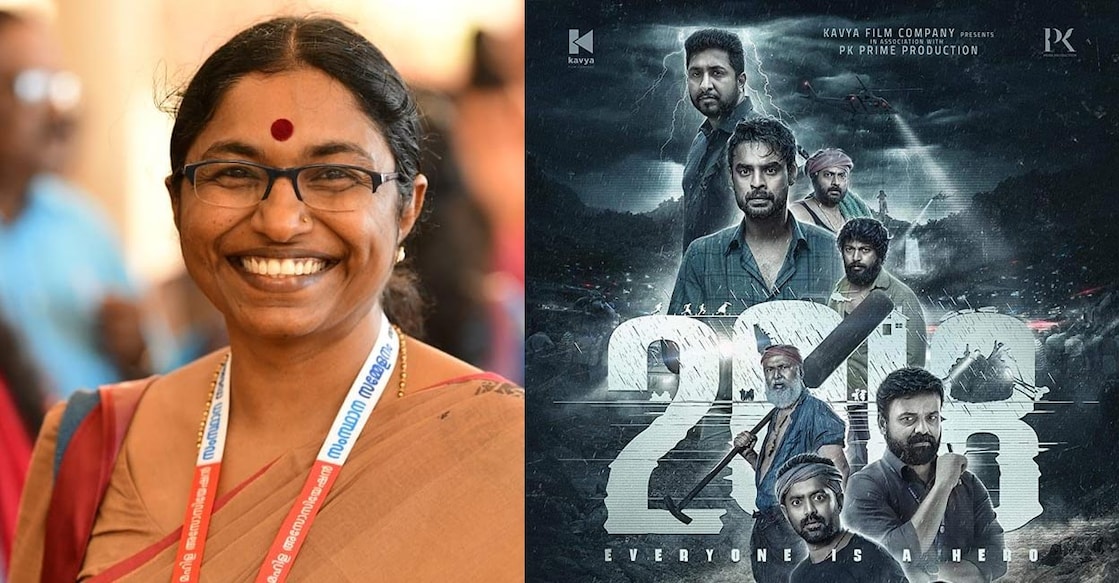Jude Anthany Joseph's '2018' is a movie made up of distorted facts: P S Sreekala

Mail This Article
Kerala Knowledge Economy Mission director and writer P S Sreekala has strongly criticised the Jude Anthany Joseph directed film ‘2018’ based on the Kerala floods. She wrote on Facebook that the film has been made with some distortions, camouflaging, and lies along with the truth and that the director hasn’t done the research necessary for such a film. The note says that the film portrays the chief minister as helpless when he was at the forefront of the rescue operations during that time.
She pointed out that the youth came forward voluntarily under the leadership of the local self-governing institutions and that there are no school buildings in Kerala that are on the verge of collapsing during the rainy season as shown in the movie. Her note ends with the question of whether there is any difference between media that spreads lies and artistic expression if there is no honesty in it.
The full text
Presentation of half-truths is as dangerous and scandalous as propaganda. Cinema is an area that has benefited greatly from the development of technology. It is in this context that some films are able to attract a large audience at the national level. It looks like such films needn’t be celebrated. On the contrary, it would be a pity not to use such possibilities according to the content.
But it is a clever strategy to harness the best of technology to turn cinema into a propaganda medium. That strategy is even more effective if the director knows his craft. Jude Anthany has applied that strategy well in the film. The director was heard saying that this film was born out of his guilt. I don't know if he really said that. If he has said that then the guilt should come from the unscientific observation that the opening of the dam was the cause of the 2018 floods. And the film more or less tries to establish that theory to an extent.
It is heartening to witness the film acknowledging the contributions of Keralites who plunged wholeheartedly into the rescue operations. But there was also a unique declaration of solidarity that came from the Chief Minister of Kerala during that time. But the film shows a CM who sat helplessly during the crisis.
The film seems to be a documentation of the floods that occurred four-five years ago along with the public rescue operations. That is wrong. Take, for example, the segment that shows the fishermen becoming Kerala's volunteer army. There were fishermen belonging to different religions and castes. But in the film, the fishermen are shown to start the operations after the approval of a priest from a particular Christian community. The rescuers are the ones who put their faith in the people's representatives and the government and are confident that they will be there to lead. There was a government system to provide the facilities they needed within the constraints of the floods. The chief minister was there to lead from the front. The director seems to have deliberately overlooked it.
The director hasn’t bothered to do the research necessary for such a film. There were a few casteist folks who refused to get into the boats that reeked of fish. The main hurdles before the boats were the large gates and walls in front of many homes. The youth came forward voluntarily under the leadership of the local self-governing institutions. They were coordinated by local governments.
The chief minister honoured the bravery of the fishermen who plunged into the rescue operation with boats irrespective of caste and religion by giving the 'Big Salute' of Kerala. In this way, there are many events that we know are true.
Looks like the director has only seen a boat called Mary Matha. And it has been made into a symbol, a memorial of the flood era! If that is the case, shouldn’t they have made the memorial in the name of the fisherman who was the owner of the boat, who initiated the operations and spoke to the priest? He saved so many people. He is shown to die when he tries to remove a roof tile during the floods. (Maybe this is common during the rainy season. But otherwise, they are showing that school as a dilapidated building. I am not aware of a school in 2018 that had its roof tiles falling apart.
Not only that but there is something that has been evaluated by national research agencies after the floods that ravaged Kerala. It was said that it would take at least 20-30 years for Kerala to recover from the floods. However, there are no remnants of the floods left in Kerala today. The director may have his own (political) reasons for his reluctance to say that Kerala has a government that has resurrected the people with confidence by compensating them for all the losses, including the boat and the house. But while doing such themes, don’t try to bring in such counterfactual narratives over an incident that has slowly been erased from our memory.
2018 is a film based on certain factual distortions, camouflages, lies, and some truths. What is the difference between art without honesty and justice and media that spread lies?,” she asks.

